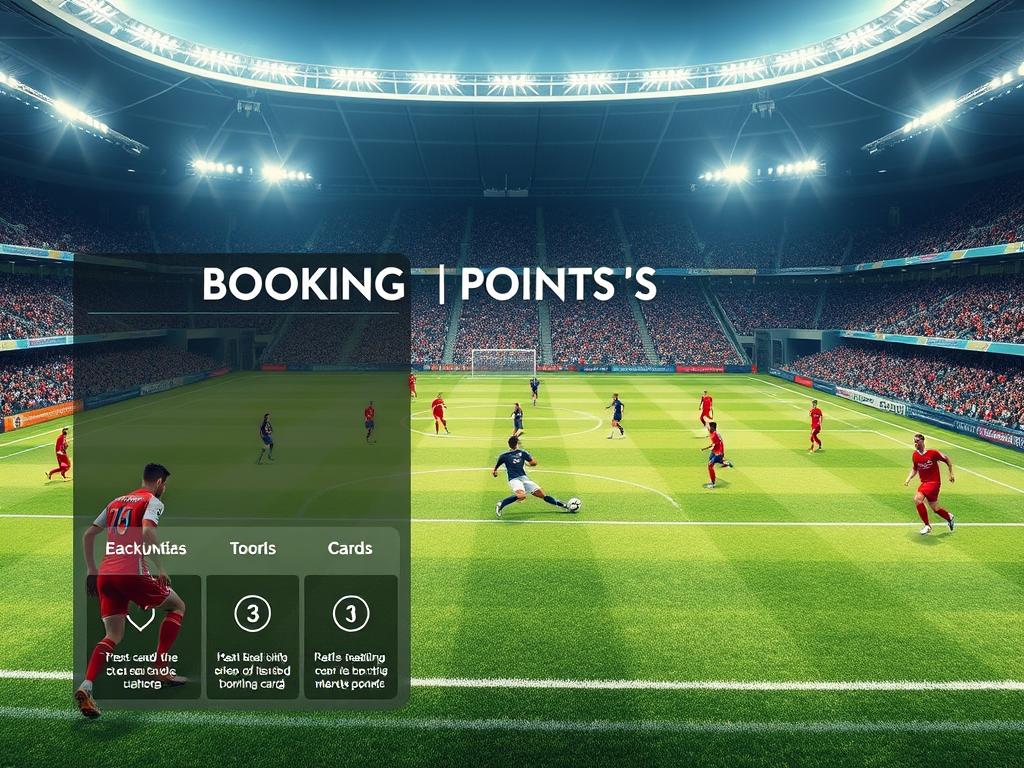Referees use a unique method to track player discipline during a match. This method involves assigning values to yellow and red cards. These values are called booking points. They help fans and bettors understand the flow of the game better.
A yellow card is worth 10 booking points, while a red card carries 25 points. If a player receives two yellows, leading to a red, it totals 35 points. This system adds excitement to soccer betting, allowing fans to predict the total cards in a match.
Whether you’re new to soccer or a seasoned fan, this guide will help you understand the mechanics behind booking points. It’s designed to make your betting experience more strategic and informed. Let’s dive in and explore how this system works!
Understanding What Is a Booking Points System in Soccer
Player behavior on the field can directly impact betting outcomes through a unique system. This method assigns specific values to yellow and red cards, creating a way to quantify discipline during a match. For bettors, this system opens up a whole new layer of strategy.
Defining the Booking Points Concept
In soccer betting, booking points are a way to measure player discipline. Each card shown by the referee carries a point value. These points are tallied to create a total for the match, which bettors can use to make informed decisions.
Why does this matter? Understanding this system helps you predict how a game might unfold. It also allows you to analyze team behavior and referee tendencies, giving you an edge in the betting market.

How Yellow and Red Cards Translate to Points
Yellow cards are worth 10 points each, while red cards carry 25 points. If a player receives two yellows, leading to a red, the total points for that incident are 35. This immediate translation of cards to points is crucial for bettors to grasp.
For example, in a game where one team gets four yellows and one red, their total points would be 65. The opposing team with three yellows and two reds would accumulate 85 points. These numbers help you assess the overall discipline of the match.
Key takeaway: Knowing how cards translate to points allows you to make smarter bets. It’s not just about the number of cards but understanding their impact on the game.
How the Booking Points Mechanism Works
The booking points mechanism transforms how fans and bettors analyze soccer matches. It assigns specific values to yellow and red cards, creating a measurable way to track player discipline. This system not only adds excitement but also opens up new strategies for betting enthusiasts.

Point Values and Calculation Examples
Each card shown by the referee carries a set point value. A yellow card contributes 10 points, while a red card adds 25. If a player receives two yellows, leading to a red, the total points for that incident are 35.
Here’s an example: In a match, Team A gets three yellows and one red. Their total points would be 55. Team B, with four yellows and two reds, would accumulate 90 points. These calculations help bettors assess the match’s overall discipline.
Over/Under and Range Betting Formats
Bookmakers often set lines for over/under bets. For instance, an over/under 60 line means you’re betting whether the total points will exceed or fall below 60. Range betting groups totals into categories like 0-30, 31-60, and 61+.
Understanding these formats allows you to make smarter decisions. For example, in a high-stakes derby, referees might show more cards, making higher ranges more likely. This knowledge can give you an edge in your betting strategy.
Key Factors and Strategies in Booking Points Betting
Understanding team dynamics and referee tendencies can significantly improve your betting strategy. By analyzing these factors, you can make more informed decisions and increase your chances of success in the booking points market.
Team Discipline and Player Behavior
Team discipline plays a crucial role in determining the total booking point in a match. Teams with a more aggressive playing style often accumulate higher number card totals. For example, in the Premier League, certain teams are known for their physical approach, leading to more yellow and red cards.
Individual player behavior also impacts the card worth. Players with a history of frequent fouls or unsportsmanlike conduct are more likely to receive cards. Analyzing player statistics can help you predict potential incidents during a football match.
Role of the Referee and Match Context
Referees have a significant influence on the flow of the game. Some referees are known for their strictness, issuing more cards, while others are more lenient. Understanding a referee’s tendencies can give you an edge in point betting.
The context of the match also matters. High-stakes games, such as derbies or cup finals, often see a higher number booking due to increased intensity and rivalry. For instance, matches in the Premier League between fierce rivals often result in more cards being shown.
By considering these factors, you can better predict the total booking point and make smarter bets. Always review historical data and referee statistics before placing your wagers.
Analyzing Games and Markets for Booking Points Bets
High-intensity matches often reveal patterns in player discipline that can shape betting outcomes. Derbies and rivalries, in particular, are known for their fiery clashes, making them a goldmine for analyzing total booking points. By diving into these games, you can uncover trends that help you navigate the betting market more effectively.
Popular Derbies and Competitive Rivalries
Matches like the North London Derby and El Clasico are prime examples of games that consistently deliver a lot of bookings. These high-stakes encounters often see players pushing limits, resulting in more yellow and red cards. For instance, the North London Derby averages over 40 booking point totals per match, making it a favorite for bet booking strategies.
Similarly, El Clasico, featuring Barcelona and Real Madrid, is another game where intensity leads to higher card counts. Referees in these matches tend to be stricter, adding to the total booking points. Understanding these trends can help you make smarter bets in the point market.
Using Statistics and Historical Data
Statistical analysis is key to predicting booking point totals. By examining past performances, you can identify teams with aggressive playing styles or referees known for issuing more cards. For example, teams in the Premier League with a physical approach often accumulate higher yellow card worth totals.
Historical data also reveals patterns in specific leagues. Matches in Spain and Italy, for instance, tend to have higher card counts due to stricter refereeing. By leveraging this information, you can better navigate the betting market and make informed decisions.
Whether you’re analyzing derbies or using statistics, understanding these factors can give you an edge in the booking point market. Dive into the data, and let it guide your bet booking strategies for smarter, more successful wagers.
Final Insights and Next Steps for Smart Betting
Mastering the art of football betting involves understanding the finer details of player discipline and referee decisions. By analyzing team behavior and total number of cards, you can predict match outcomes more accurately.
Focus on historical data and referee tendencies to spot patterns. High-stakes games often see a higher number booking point due to intense rivalries. Use tools and statistics to make informed decisions.
Take the next step by exploring advanced betting insights. Review detailed game stats and leverage data tools to improve your chance of success. Understanding the card worth point system gives you an edge in the football betting market.
Apply these strategies to make smarter bets. Pay attention to the total number of card events and odd scenarios. With the right approach, you can turn insights into winning wagers.







